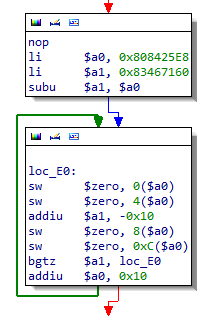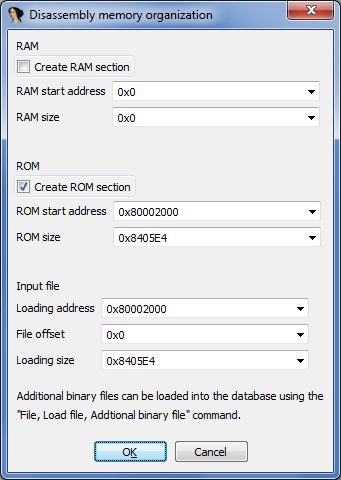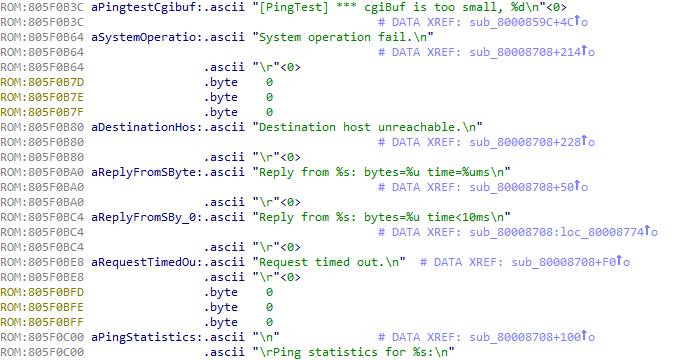This part is again specific to firmware for the EasyBox 803 (and similar models by Arcadyan), but the techniques presented can easily applied to other firmware, even on different architectures.
Now that we’ve got a file with the actual instructions we need to load it into IDA. As the file (unlike a ELF/PE binary) does not come with all the information we need to properly load it into IDA, we have to gather some information manually.
The first challenge is to find the load address. This is the memory location where the binary would be located at, if it would actually be running on the device.

I’ve reverse engineered the bootloader so I have already this information. (see unpack_loc or the second argument for printf)
Note: even if you have the bootloader you will have to find the bootloader’s load address -> chicken|egg. (btw: load address for the bootloader is 0x83000000, at file offset 0x1000!)
You can also find the address with trial and error, which basically works as follows:
- disassemble manually or with IDAPython magic
- look at operands of li (load immediate), la (load address) and lui (load upper immediate) instructions
- reload binary or relocate segment according to your observations
- your are done if you have xrefs right at the beginning of strings 🙂 (apparently parts of this process can be automatized: Reverse engineering the Airport Express Part 3)
In this case there is another option:
If you load the binary at 0x0 and make a function at 0x0 (‘p’) you will see a function which is responsible for CPU initialization. When looking further down you will see the following code:

As you can see it is zeroing out the memory between 0x808425E8 and 0x83467160. This indicates that it is setting up the .bss segment which usually comes right after the data segment.
If you would subtract the size of our input file (0x008405E3 bytes) from 0x808425E8 you would also get 0x80002000 (0x80002005 actually, but consider the rest alignment/padding).
Right after this code above we get another important information – the value of the $gp (global) pointer. This (static) pointer is frequently used for addressing data later on.

Now it’s time to load out file into IDA properly.
File > Load
Processor type: “MIPS series: mipsb”

Options > General > Analysis > Processor specific analysis options

Now start the auto-analysis by pressing ‘p’ or ‘c’ at 0x80002000.
IDA does a reasonably good job at analyzing the file:

String references match nicely too:

We will help IDA to analyze the binary further by running this IDAPython script (end of CODE is at 0x805F0520!):
def analyze_addiu_sp(curr_addr,end_addr):
addiu = "27 BD" # 27 BD XX XX addiu $sp, immediate
n = 0
if curr_addr < end_addr:
print "mipsb addiu function search between: 0x%X and 0x%x" % (curr_addr,end_addr)
while curr_addr < end_addr and curr_addr != BADADDR:
curr_addr = FindBinary(curr_addr, SEARCH_DOWN, addiu)
if GetFunctionAttr(curr_addr,FUNCATTR_START) == BADADDR and curr_addr != BADADDR and curr_addr < end_addr and curr_addr % 4 == 0:
immediate = int(GetManyBytes(curr_addr+2, 2, False).encode('hex'),16)
#Jump(curr_addr) # useful for debugging, but has performance impact
if immediate & 0x8000: # check if most sigificant bit is set -> $sp -0x1
if MakeFunction(curr_addr):
n += 1
else:
print 'MakeFunction(0x%x) failed - running 2nd time maybe fixes this' % curr_addr
curr_addr += 1
print "Created %d new functions\n" % n
return n
else:
print "Invalid end address of CODE segment!"
curr_addr = ScreenEA() & 0xFFFFFFFC # makes sure start address is 4-byte aligned
end_addr = AskAddr(0, "Enter end address of CODE segment.")
analyze_addiu_sp(curr_addr,end_addr)
Note: If you get “MakeFunction(0x80057600) failed”-errors, wait for IDA to complete its analysis and run a 2nd time.
This script takes advantage of the fact that each function (which uses stack) has an addiu $sp -immediate instruction the beginning of its epilogue. (Of course this may not be the case with other compilers!)
Now we will run a second script to convert the rest (=unexplored stuff) to functions (or at least code).
def analyze_unexplored(curr_addr,end_addr):
if curr_addr < end_addr:
print "unexplored function and code search between: 0x%X and 0x%x" % (curr_addr,end_addr)
while curr_addr < end_addr and curr_addr != BADADDR:
curr_addr = FindUnexplored(curr_addr,SEARCH_DOWN)
#Jump(curr_addr) # useful for debugging, but has performance impact
if curr_addr != BADADDR and curr_addr < end_addr and curr_addr % 4 == 0:
MakeFunction(curr_addr)
print 'done!'
else:
print "Invalid end address of CODE segment!"
curr_addr = ScreenEA() & 0xFFFFFFFC # makes sure start address is 4-byte aligned
end_addr = AskAddr(0, "Enter end address of CODE segment.")
analyze_unexplored(curr_addr,end_addr)
This script only works properly because there is not data inlined in the code segment. If that wouldn’t be the case you would get false positives (eg. code that is actually data).
Let’s create a new segment with the information we gathered earlier (alternatively we could just make the ROM segment bigger):

Note: .bss is apparently also used as stack (with $sp pointing to 0x83467160 initially) so the segment does not have to be this big to get all the references to data.
Note²: IDA fails to display all the xrefs to the new segment – Reanalyzing does the trick (Options > General > Analysis > Reanalyze program)
The first function that gets called from the entry function has a reference to the string “\nIn c_entry() function …\n”.

If you Google for this you will find logs posted by people who attached a serial cable to their Arcadyan devices and read what the device prints during boot.
Quote from http://comments.gmane.org/gmane.comp.embedded.openwrt.devel/4096:
In c_entry() function ...
install_exception
Co config = 80008483
[INIT] Interrupt ...
##### _ftext = 0x80002000
##### _fdata = 0x805BC0E0
##### __bss_start = 0x80663F44
##### end = 0x81B8C09C
allocate_memory_after_end> len 687716, ptr 0x81b940a0
##### Backup Data from 0x805BC0E0 to 0x81B9409C~0x81C3BF00 len 687716
##### Backup Data completed
##### Backup Data verified
...
It would be nice to have this information for our device too, so let’s find the function that prints this and then reconstruct its output:

Output (if I’m correct):
##### _ftext = 0x80002000
##### _fdata = 0x807989C0
##### __bss_start = 0x8083F2A0
##### __bss_end = 0x83467160
allocate_memory_after_end> len %d, ptr 0x8346F160
##### Backup Data from 0x807989C0 to 0x8346F160~0x83515A40 len 682208
We can now add another segment (backup_data).
When we search for ‘all error operands’ a lot of entries will show up. From the IDA Pro Documentation:
This commands searches for the ‘error’ operands. Usually, these operands are displayed with a red color.
Below is the list of probable causes of error operands:
- reference to an unexisting address
- illegal offset base
- unprintable character constant
- invalid structure or enum reference
- and so on...
We are only interested in the “reference to an unexisting address”-type.
The lui instructions before the error operands reveal where new segments should be added.

This would tell us that we have to add a segment at 0xBE100000 (size at least 0xFFFF)
Alternatively can search for text “lui“. If the (second) operand<<16 is not part of an existing segment, check if the register (first operand) is used for addressing data, if it is, add a new segment accordingly.
I think missing segments are (as always, I could be wrong) device memory and are not terribly interesting to me. For the sake of completeness I added them.

Continued in E03: Reverse engineering an obfuscated firmware image – MIPS ASM (“maybe, sometime”)
Note: The IDAPython scripts are based on Craig Heffner’s work over at /dev/ttyS0 – reccomended:Reverse Engineering VxWorks Firmware: WRT54Gv8
Note²: Make sure to comply with Vodafone’s terms of use.












